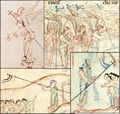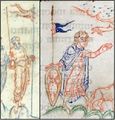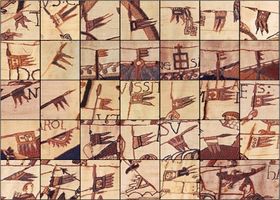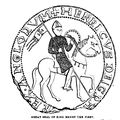Banners
| Banners |
|---|
|
More Weapons pages
Banners, standards, flags, gonfanon (gonfalon, guntfano) and pennons (pennants) were commonly adopted by the warriors of the 9th – 12th centuries. This article attempts to briefly outline what the authors currently know about the subject. The style of banner stays surprisingly consistent from the 9th to the 12th centuries and across Western Europe. For this reason we’ve decided to look at all the evidence together rather than, as we usually do, break the evidence into English, Carolingian, etc.
From Art
Pennons
These are triangular flags or streamers.
Banners
These are rectangular flags ending in ‘swallowtails’.
Before 1066AD
- Banner Leiden I Maccabees f.15v.jpg
850-950AD Carolingian
Leiden I Maccabees f.15v - Banner Leiden I Maccabees f.22r.jpg
850-950AD Carolingian
Leiden I Maccabees f.22r - Banner Aachen Liuthar Gospels a.jpg
990AD Ottonian
Aachen Liuthar Gospels - Banner Aachen Liuthar Gospels b.jpg
990AD Ottonian
Aachen Liuthar Gospels - Banner BL Cotton Tiberius C VI f.8v.jpg
1050AD English
BL Cotton Tiberius C VI f.8v - Banner BL Cotton Tiberius C VI f.9r.jpg
1050AD English
BL Cotton Tiberius C VI f.9r
The Bayeux Tapestry
After 1066AD
- Banner Dijon MS14 f.13v a.jpg
1109-1111AD French
Dijon MS14 f.13v - Banner Dijon MS14 f.13v b.jpg
1109-1111AD French
Dijon MS14 f.13v
From Literature
For a full list of banners mentioned in primary sources see Banners from Literature
Late Roman Draco Standards
Art
Literature
|
"Hic arripiens signum quod apud eo habebatur sacrum, leonis atque draconis desuper aquilae volantis insignitum effigie ..." |
|
About Witikind, an adversary of Charlemagne. [OAKESHOTT 1960:p178] |
Archaeology
--
Discussion
"... be the end would have been different. But Harold was struck, and cut down by a Norman sword when William's knights burst through the Huscarles to trample down the Dragon standard and Harold's banner of the Fighting Man." [OAKESHOTT 1960:p.180]
References
<nocite> BACON1914 GILES1847 GUMMERE1910 HEWITT1885 LAING1907 OAKESHOTT1960 SELLAR1907 SWANTON2000 TAYLOR1837 </nocite> <biblio force=false>#Template:Bib</biblio>










